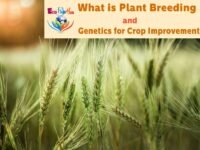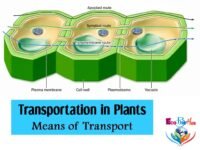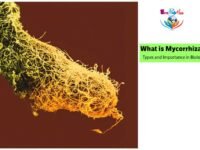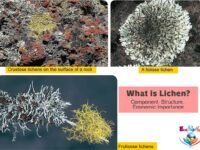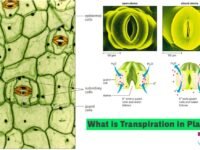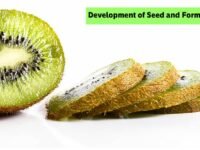In this tutorial, we have defined ‘What is Plant Breeding and Genetics for Crop Improvement‘ based on the following topics:
01. Improvement in crop variety
02. Management of crop production
03. Management of crop protection
► Read More: What is Algae? Definition, Classification, Examples ► Read More: What is Plant Tissue Culture & Application in Modern Science ► Read More: What is Fungi? Definition, Classification, Examples ► Read More: Origin of Life (Biopoiesis) and Origin of Universe ► Read More: What is Life? Definition & Characteristics of Life ► Read More: Transportation in Plants || Means of Transport
TABLE OF CONTENTS
INCREASE IN FOOD PRODUCTION BY CROP IMPROVEMENT
All living beings require food for their maintenance and survival. Two major sources of food are crop plants and animals. With an increase in human population there is growing demand of food resources. For such a huge population, million million tonnes of food consumed every year. With not much scope for increasing the area for cultivation, it becomes essential to improve the already existing crop varieties to have more yield. Therefore, the prime concern of present day agricultural scientists is to increase food production without degrading our environment and disturbing the balance of nature to meet the needs of present generation. This increase in food production has been achieved through the improvement in three stages as follows:
01. Improvement in crop variety
02. Management of crop production
03. Management of crop protection
► Need for Crop Improvement
➢ Continuous increase in human and animal population has created a need for increased food and fodder production.
➢ To increase the productivity of cultivated crops due to limited land area under cultivation.
➢ Increased standard of living, health consciousness and competition in market for quality products.
➢ To compensate the loss caused by various biotic and abiotic factors.
➢ In view of the deterioration of natural resources (soil, water and weather), there is a need for improved crop varieties.
► Crop Improvement by Plant Breeding
The technique of combining desirable and superior characteristics from selected plants in one plant and then multiplying such plant to be made available to farmers for cropping is known as crop improvement. Since it involves plant breeding techniques, the branch of science concerned with the improvement of crop varieties is called plant breeding.
Plant breeding as a technology has increased agricultural yield to a large extent. Green revolution has enabled our country not only to become self-sufficient, but also to export food grains to other countries. The green revolution become possible to a large extent because of plant breeding techniques for the development of high-yielding, disease-resistant, pest-resistant, drought-resistant or regionally-adapted varieties in Wheat, Rice and Maize, etc.
India is primarily an agricultural country. About 62% of the country’s population depends on agriculture, Agriculture accounts for nearly 33% of nation’s GDP. At the time of independence in 1947, total wheat production was just 6.5 million tonnes which was far less than actual requirement. Since independence, the major problem before the country was to produce enough food for the increasing population. As only limited land was fit for cultivation, efforts were started to increase the yield per acre. With the help of plant breeding techniques, several high-yielding and disease-resistant varieties of wheat and rice were developed in mid 1960s. This led to a dramatic increase in food production making the country not only self-sufficient but also surplus in food production. This phase of tremendous increase in food production is known as Green Revolution.
► Historical Account
➢ As early as 700 BC, Assyrians and Babylonians used to cross pollinate date palms artificially.
➢ In 1694 Camararius proved that there is sexual differentiation in plants. In 1717, Thomas Fairchild produced the first hybrid plant artificially.
➢ In 1761, Cotton Mather recognized the process of natural selection in maize.
➢ During 19th and 20th centuries, techniques of plant breeding like, selection, hybridization, were improved. L.L. Vilmorin (France), Burbank (USA), Michurin (USSR) are some of the famous plant breeders of that time.
► Important Plant Breeders
➢ N.I. Vavilov – Famous Russian plant breeder, who gave centres of origin of cultivated plants.
➢ N.E. Borlaug – Famous Mexican plant breeder, who was awarded Nobel Peace Prize (1970) for developing high yielding dwarf wheat varieties like Norin-10, Sonora64, Lerma rojo-64, etc. He is known as “Father of green revolution”.
► Indian Plant Breeders
➢ Sir. T.S. Venkatraman – Pioneer Indian Plant breeder famous for sugarcane improvement.
➢ Choudhary Ram Dhan – Wheat breeder, who is famous for C-591 variety of wheat, which made Punjab as wheat . granary of India.
➢ Dr. B.P. Pal – Famous wheat breeder, who produced many NP wheat varieties.
➢ Dr. K. Ramiah – Famous rice breeder of international fame.
➢ Dr. Pushkar Nath – Famous potato breeder.
➢ Dr. Boshi Sen – Famous maize breeder.
➢ Dr. M.S. Swaminathan – He is a pioneer mutation breeder. He has produced Sharbati Sonora, a variety of wheat by mutation, which is responsible for green revolution in India. Dr. Swaminathan is called ‘Father of green revolution in India”
PLANT BREEDING
■ What is Plant Breeding?
Plant breeding is a technique of improvement of economically important crop plants and production of new crops that are better suited for the cultivation, give better yield and are disease-resistant. Recorded evidences indicate that plant breeding started with the domestication of wild plants 9,000–11,000 years ago. Almost all our present day crops are derived from ancient domesticated varieties through plant breeding.
Classical plant breeding involves the hybridisation (crossing) of pure lines having desired characters, their hybridisation followed by artificial selection to produce plants with the desired characters of higher yield and resistance to diseases. Improvements in crop plants are being carried out with the help of molecular genetic tools and tissue culture.
■ Objectives of Plant Breeding
The aim of plant breeding is to develop new varieties which combine as many of the desirable and beneficial characteristics of economic value as possible. These are:
01. Growing High-yielding Varieties (HYV): Through artificial selection, cross-breeding and hybridisation, high-yielding varieties can be developed with higher productivity of crop per acre of land. It is the most important criterion for evaluating a new variety of crops.
2. Growing Improved quality Varieties: Crop varieties with enhanced nutritional values, taste and long shelf life can be developed. Three varieties of Maize, namely Shakti, Rattan, and Protina have been developed, evaluated and released for cultivation.
3. Growing Stress-resistent Varieties: The crop varieties with higher resistance against diseases, parasitic infections, heat, salinity, water logging, drought, frost, etc. are being developed.
4. Growing Disease-free or Disease-resistant Strains or Varieties: It provides a hazard-free method of controlling plant diseases. Almost all modern-day varieties have a genotype that provides resistance to important crop diseases.
5. Growing Pest-resistant Varieties: Pests are insects and molluscs which feed on plant parts and destroy them. The genotypes of wild varieties are found to have genes that provide them protection against pests and parasites. This is the reason, those wild varieties should be conserved and used as a source for pest-resistant genes.
A cultivated variety having the majority of the above characters is regarded as a superior variety. This superiority or improvement may be in the following respects:
➢ Quantitative characters: Increase in yield of seeds, grains, fibres, oils, etc.
➢ Qualitative characters: Increase in biochemical components as well as taste, milling, baking, cooking, etc.
➢ Resistance to disease, insects, pests, drought, frost, cold, lodging, etc.
➢ Earliness or lateness in maturity period or change in maturity behaviour.
➢ Adaptability to a wider range of conditions, etc.
The cultivated or domesticated varieties are crossed with wild varieties and resistant hybrids are selected.
■ Implementation of Plant Breeding
01. Plant Breeding for Disease Resistance
Crop plants grown in tropical climates are attacked by fungal, bacterial and viral pathogens. Crop losses caused by these pathogens are substantial reaching up to 20 -30% and sometimes even total. Before breeding is undertaken, it is essential to know about the causative organism and its mode of transmission,
(i). By fungi: Brown rust of Wheat, red rot of Sugarcane and late blight of Potato.
(ii). By bacteria: Black rot of crucifers.
(iii) By viruses: Tobacco mosaic, Turnip mosaic, etc.
Breeding and development of disease-resistant cultivars or varieties enhance food production and reduces the dependence on fungicides and bactericides.
Before breeding is undertaken, the pathogens responsible for various diseases of a crop are identified. Their mode of transmission and effect on the host are studied. This is also helpful in the study of the effect of pathogens or their wild varieties related species and management practices.
● Conventional Breeding Technique for Disease Resistance
Incorporation of disease resistance is the only means of preventing diseases like viral diseases, wheat rusts, etc. Disease resistance is the ability of the plant to remain unaffected even when attacked by pathogens. When the host genotypes do not allow the pathogens to grow and flourish over them, they form resistant host lines.
The conventional breeding technique for obtaining disease-resistant varieties consists of hybridisation and selection.
The various sequential steps of this technique are:
(i). Screening germplasm
(ii). Hybridisation of selected parents
(iii). Selection and evaluation of the hybrids
(iv). Testing and release of new varieties.
Some crop varieties developed through hybridisation and selection for resistance to fungal, bacterial and viral diseases are given in the below Table.
TABLE: Some Common Disease-Resistant Crop Varieties Developed in India
| Crop | Variety | Resistance to Diseases |
| 1. Wheat | Himgiri | Leaf and stripe rust, hill burnt. |
| 2. Brassica | Pusa swarnim (Karan Rai) | White rust. |
| 3. Cauliflower |
Pusa Shubhra, Pusa Snowball K-1 | Black rot and Curl blight black rot. |
| 4. Cowpea |
Pusa Komal | Bacterial blight. |
| 5. Chilli |
Pusa Sadabahar | Chilly mosaic virus, Tobacco mosaic virus and leaf curl. |
There is constrain in conventional breeding due to the availability of a limited number of disease resistant genes that are present and identified in various crop varieties or wild relatives. By inducing mutations in crop plants through diverse means may get the desirable gene available in the plant material. Plants with such desirable characters (or genes) may be either multiplied directly or can be used in breeding. Other breeding methods are selection amongst somaclonal variants and genetic engineering.
02. Plant Breeding for Developing Resistance to Insect Pests
Insect and pest infestation is another major cause for large scale destruction of crop plant and crop produce. Biochemical, morphological or physiological characteristics are used for insect resistance in host crop plants are:
(i). Hairy leaves in several plants are associated with resistance to insect pests, e.g., resistance to jassids in cotton and cereal leaf beetle in wheat.
(ii). Solid stems in wheat lead to non-preference by the stem sawfly.
(iii). Smooth leaved and nectar-less cotton varieties do not attract bollworms.
(iv). High aspartic acid, low nitrogen and sugar content in maize lead to resistance to maize stem borers.
Methods of breeding for insect pest resistance involve the same steps as those for any other trait such as yield or quality as discussed above. Resistant genes are made available in frog cultivated varieties, germplasm, collections of the crop or wild relatives.
Some insect pest resistance crop varieties are developed by hybridisation and selection and are shown in the below Table.
TABLE: Some Common Pest Resistant Varieties
| Crop | Variety | Insect Pests |
| 1. Brassica (rapeseed mustard) | Pusa Gaurav | Aphids |
| 2. Flat bean |
Pusa Sem 2, Pusa Sem 3 | Jasids, Aphids and Fruit borer |
| 3. Okra (Bhindi) | Pusa Sawani, Pusa A-4 | Shoot and Fruit borer |
● Quarantine
Sometimes, along with the introduced materials, new weeds, insect pests and disease-causing organisms also enter the country. Argemone maxicana is one such weed that entered India with the introduction of some plant material. Therefore, all introductions are carefully examined for the presence of weeds and insects and disease-causing organisms. This is known as quarantine.
03. Plant Breeding for Improved Food Quality
In spite of the substantial increase in food production, more than 840 million people in the world do not have adequate food to meet their daily requirements. A far greater number is not getting quality food. About 3 billion people in the world suffer from micronutrients, protein and vitamin deficiency. The deficiency of nutrients in the diet is called hidden hunger. These people cannot afford to buy adequate vegetables, fruits, legumes, fish and meats. Diets lacking essential micronutrients, particularly iron, vitamin A, iodine and zinc increase the risk for disease, reduce life span and mental ability.
■ Steps in Plant Breeding
New varieties of plants can be developed by introducing variations or differences in the genetic composition of the existing varieties and then selecting the varieties with desired character or characters. The process involves following steps:
I. Selection and testing of superior recombinants
II. Introduction of genetic variations
III. Evaluation, release and commercialisation of new cultivar varieties
IV. Multiplication of improved seeds and their release to farmers
I. SELECTION AND TESTING OF SUPERIOR RECOMBINANTS
Selection is an essential step in all breeding experiments. It has been practised by man since the early days of agriculture. The selection involves picking up the better ones out of the entire crop plants. The selected plants are separated from the inferior one and are favoured by reproducing them under controlled conditions. The seeds so formed from selected plants are harvested to raise the next generation. The rest of the plants are rejected. The extent of improvement of a character in the crop plants of next-generation depends mainly on the effectiveness of selection.
■ Types of Selection
There are three patterns of selection: Mass selection, Pure line selection and Clonal selection.
01. Mass Selection
This is the most common and old method of crop selection. It has been successfully employed for the improvement of cross-pollinated plants such as Maize, Watermelon, Radish, Grapes, Apples, Onion, Pear, etc. In this selection large number of similarly-appearing plants are selected for the desired trait and their seeds are mixed together. The mixture of seeds so obtained is sown to raise the new crop. By such a selection general level of population is improved. The seeds of such plants are multiplied and supplied to the farmer.
➪ Drawbacks of Mass Selection: Mass selection is a quick and easy method of crop improvement but it has the following drawbacks:
(i). It is not very effective in bringing about an increase in the yield which is dependent mostly on the environment.
(ii). The selection is made from the female individuals and there is no check on the male plant which contributes equally to the progeny.
(iii). It is not possible to know whether the superior phenotype is due to a better genotype or due to the environment.
(iv). Selected characters of the crop exhibit segregation because of natural cross pollination.
02. Pure Line or Single Plant Selection
The pure line is the progeny of a single homozygous, self-pollinated plant. The plants with desired trait or traits are selected out of the variable population in the field. Seeds from selected plants are sown in separate rows to produce a progeny by self-pollination. Desired plants are again selected from this progeny and self-pollinated. This is continued for several generations. The inferiors are eliminated from each generation. Wheat varieties like Kalyan-227 and PV-18 have been developed at Ludhiana by this type of selection.
➪ Advantages of Pure Line Selection: It is better than mass selection because the selected plants retain desired characters for several generations.
➪ Drawback of Pure Line Selection: The main drawback of this method is that it takes 10–12 years for raising the desired variety.
03. Clonal Selection
It is practised in vegetatively propagated plants like Sugarcane, Banana, Potato, etc. In this method, the best plant based on phenotypic characters is selected. It is then multiplied vegetatively and supplied to the farmers. A population of plants raised from a single vegetatively propagated plant is called Clone.
➪ Advantage of Clonal Selection: The advantage of this method is that a desired clone can be obtained within one year. But this method can be applied only to vegetatively propagated plants.
A. Clonal Selection in Self-pollinated Crops:
Self-pollination introduces homozygosity faster because pollen from a flower falls on the stigma of the same flower. As a result, various populations of self-pollinated crops show homozygosity for different genotypes. Therefore, selection in such crops isolates the best homozygous genotypes, present in the population. These form separate varieties. Homozygosity in such varieties is maintained by self-pollination. The self-pollinated progeny of a homozygous plant represents a pure line and their selection is called pure line selection.
All the plants in a pure line will have identical genotypes. The variations shown by them are due to the environmental effect.
B. Clonal Selection in Cross-pollinated Crops:
Populations of cross-pollinated crops have more heterozygous than homozygous, because pollen from the flower is deposited on the stigma of flowers of other plants. It means a cross-pollinated population contains plants of several genotypes, all different for different characters. Some of these heterozygous genotypes are found to be superior, whereas homozygous genotypes are inferior and are eliminated during selection.
Selection in cross-pollinated crop plants is for increasing the frequency of superior genotypes without reducing heterozygosity. Selection is carried out for successive generations.
C. Clonal Selection in Vegetatively Propagated Crops:
Some agricultural crops and a large number of horticultural crops are vegetatively propagated. Sugarcane, Potato, Sweet Potato, Turmeric, Banana, Apple, Pear, Peaches, Guava, etc. are propagated vegetatively. The veg tively grown progeny is exactly identical to the parent both in phenotype and genotype. The advantage of vegetative propagation is to preserve the genotype of the parent (homozygous or heterozygous) indefinitely generation after generation.
The plants produced through vegetative propagation from one plant form a clone. All the individuals of a single clone have identical genotype. The phenotypic variations within a clone are due to the environment.
■ Procedure of Selection
Selection involves the following steps:
01. Selection of desired plants among the progeny of the hybrids, i.e., those plants that have the desired character combination.
02. Selfing the selected plants through several generations to produce uniform homozygous inbred lines.
03. Crossing the selected inbred lines to produce a uniform F1 population of desired quality or qualities, and then F1 seeds can be grown directly.
Selection is different in self-pollinated and cross-pollinated crops.
A. Selection in Self-pollinated Crops:
Self-pollinated crops gradually become homozygous. Selection in self-pollinated crops isolates the best homozygous genotypes present in the population. These genotypes form separate varieties. Homozygosity in such varieties is maintained by self-pollination. The self-pollinated progeny of a homozygous plant represents a pure line and their selection is called pure line selection. All the plants in a pure line will have identical genotypes. Variations shown by them are due to environmental effect.
B. Selection in Cross-pollinated Crops:
Populations of cross-pollinated crops have more heterozygous populations than homozygous populations because pollen from one flower is deposited on the stigma of flowers of other plants. It means a cross-pollinated population contains plants of several genotypes, all different for different characters. Some of these heterozygous genotypes are found to be superior, whereas homozygous genotypes are inferior and are eliminated during selection.
II. INTRODUCTION OF GENETIC VARIATIONS
Differences or variations in the gene composition of plants or individuals of a group on population or species are called genetic variations.
They are heritable variations because they are passed on from parents to their offspring. They arise due to changes in the genotype and are useful for selection. The genetic variations can be introduced by the following methods:
01. Domestication
02. Collection of variability
03. Plant introduction
04. Hybridisation
05. Mutation Breeding
06. Polyploidy
07. Tissue culture
08. Genetic engineering
01. Domestication
Domestication is the process of bringing wild species under human management. The present day cultivated plants have been derived from wild species. Most of the present-day crops were by prehistoric man. Some new plant species are still being domesticated.
02. Collection of Variability (Germplasm Collection)
The sum total of genes (the hereditary material) present in all the individuals of a species is known as the germplasm of that species. Thus, germplasm collection is the collection of a large number of genotypes of a crop species and its wild relatives. The germplasm collection also includes the storage of germplasm in gene banks. Germplasm collection furnishes the richest sources of genetic variability for crop improvement.
The germplasm of a crop plant consists of:
(i). All cultivated improved varieties.
(ii). Improved varieties that are no more in cultivation.
(iii). Old local or ‘desi’ varieties.
(iv). Pure lines produced by plant breeders.
(v). Wild varieties, primitive races and exotic species related to the crop species.
The entire collection of plants and seeds having all the diverse alleles for all genes in a given crop is called germplasm collection. Germplasm of wild varieties, primitive races and exotic species is conserved to provide genes of different values to the plant breeders for crop improvement.
Germplasm is collected under the guidance of International Board of Plant Genetic Resources (IBPGR). Germplasm collections are conserved live in seed banks. Conserved seeds are of two types:
A. Orthodox Seeds: These are kept at a low temperature (-10°C to -20°C) under anaerobic condition. Since the ability of stored seeds to germinate decreases with storage time, they are grown periodically to obtain fresh seeds.
B. Recalcitrant Seeds: These can be stored only under aerobic humid conditions at room temperature for a shorter duration. Their germplasm is conserved as live plants in orchards and gardens along with fruit trees. All types of germplasm can be conserved as shoot cultures under controlled aseptic conditions in tissue culture laboratories. It can also be cryopreserved (preservation at a very low temperature).
Germplasm collections are carried out from areas where agriculture methods are still primitive and where relatives of crop plants are still living in as wild. These collection centres are in Peru, Bolivia, Chile, Middle East, South-east Asia, Ethiopia and the Mediterranean.
Genetic Erosion
The gradual loss of variability in the cultivated forms and also the loss of their wild relatives due to human activities is called genetic erosion. International Board of Plant Genetic Resources (IBPGR) is greatly concerned with this genetic erosion and coordinates germplasm conservation throughout the world. The germplasm of wild varieties, primitive races and exotic species is conserved to provide genes of different values to the plant breeders for crop improvement.
IBPGR is now known as IPGRI, i.e., International Plant Genetic Research Institute. It is located in Italy.
➢ International Crops Research Institute for Semi-Tropics: It is located in Hyderabad. It is responsible for the collection and conservation of germplasm of Chick Pea, Pigeon Pea, Sorghum, Groundnut and Pearl Millet. ➢ Central Institute of Cotton Research (CICR): It has the germplasm of over 4,000 varieties and 28 species of Gossypium (Cotton). ➢ Central Potato Research Institute (CPRI): It has the germplasm of several varieties of Potato. ➢ Central Rice Research Institute (CRRI): It stores the germplasm of several varieties and species of Rice. ➢ Sugarcane Breeding Institute (SBI): It preserves the germplasm of several varieties of Sugarcane plants. Germplasm collections are made under the supervision of the National Bureau of Plant Genetic Resources (NBPGR).
03. Plant Introduction
The process of introducing new plants from their growing place to a new locality with a different climate is termed plant introduction. The adjustment of such plants to their new locality is called acclimatisation. The new crops or the new varieties may be introduced in the form of seeds or cuttings imported. Plant introduction is a rapid method to effect improvement with minimum effort and costs.
Plant introduction has been an important basis of agricultural development throughout the world. For example, Groundnut was introduced in India at the beginning of the 19th century from the Philippines, Cinchona from Peru in 1860, Papaya from West Indies, Potato from South America, Pineapple and Rubber from Brazil. Custard apple, Coffee, Tea, and Tobacco are other plants successfully introduced in India.
The early introduction of crops was made by explorers and adventurers. The major introduction of economic plants occurred in 1492 when Christopher Columbus landed in the Bahamas (an island in the Caribbean sea) and collected and transported the wild plants to his native country. Now, the introduction of crop plants and plants of economic importance is carried out by scientists and some international agencies under strict quarantine checking. The newly introduced crops get stabilised in new areas adapting to new soil and new climatic conditions and interacting with local crops. In India, at present, National Bureau of Plant Genetic Resources (NBPGR) at IARI, Delhi is engaged in plants introduction, evaluation and maintenance of germplasm of crop plants. Plants found suitable for the new habitat are picked up for further propagation.
04. Hybridisation
Hybridisation is the technique of introducing characters of two desirable species into a single offspring (hybrid) by means of artificial pollination to create new genetic combinations. It is the mixing of two different lines, differing in their genetic composition.
A line represents a group of individuals or plants descended from the same or related parents. The individuals or lines used in hybridisation are called parents. For example, the high protein quality of one parent may need to be combined with disease resistance from another parent. This is possible by cross hybridising the two parents to produce hybrids that genetically combine the desired characters in one plant.
Hybrids are the first generation (F1) crosses between genetically different parents. The term ‘hybrid‘ is used to describe the individuals that are heterozygous even for a single gene. Hybrids are known for their vigour, growth, size and yield. As a result of hybridisation, hybrid varieties of cereals, oilseeds, pulses, sugarbeet, onion, tomato and fruits have been developed. The process of hybridisation involves the following steps: (i). Selection of desired plants from the open pollinated population. (ii). Selfing the selected plants through several generations to produce uniform homozygous inbred lines, and (iii). Crossing the selected inbred lines to produce a uniform F1 population of desired quality or qualities, and then F1 seeds can be grown directly. The hybrids produced in this way are superior to the homozygous inbreeds and excel in the natural populations. But, hybridisation is a time-consuming and tedious process because: (i). Pollen grains from the desired plant chosen as a male parent have to be collected and placed on the stigma of the flowers selected as a female parent. (ii). It is not necessary that the hybrids do combine the desired characters. Usually, only one in a few hundred to a thousand crosses shows the desired combination. Based on the taxonomic relationship of two parents, hybridisation may be: (i). Intravarietal Hybridisation: It is the process of crossing between two plants belonging to the same variety. (ii). Intervarietal Hybridisation: It is the process of crossing between individuals of different lines or varieties of the same species. (iii). Interspecific Hybridisation: It is the process of crossing between individuals of two different species. (iv). Intergeneric Hybridisation: It is the process of crossing between individuals of two different genera. Hybridisation in selected plants involves the following steps: (i). Selection and Isolation of Plants: First, the plants to be used as male and female selected. These plants are induced to flower at the same time. Crossing is done in a greenhouse under controlled conditions. (ii). Emasculation: When both the parent plants have bisexual flowers, the stamens of one plant are removed in the bud stage. This is called emasculation. (iii). Bagging: Female flowers are covered with polythene or paper bags so that no foreign pollen may fall on the stigma. This is called bagging. (iv). Tagging: The emasculated and bagged flowers are tagged by writing every step with date and time. (v). Artificial Pollination: Bags are opened at the time when the act of pollination is to be performed. After that the female cross-pollinated, flower is again bagged. If the plants are dioecious, the male plants are completely eliminated from the vicinity of the female plants which are to be cross-pollinated by pollen of the desired species. Many crop plants like Maize, Wheat, Sorghum, Barley, Carrots, Cucumber, Tomatoes, and Onions may have male sterile plants. Their male sterile plants are used as the female parent and are crossed by pollen of male parent with desired characters from other sources. This avoids the time consuming process of emasculation and bagging. It also overcomes the chances of failure in hybridisation likely to be caused by injury to flowers during the acts of emasculation and artificial pollination. The aims of hybridisation are (i). transfer of one or few qualitative characters, and (ii) use of F1 as a hybrid variety. It refers to the exhibition of the superiority of the hybrid over both of its parents in one or more traits such as the ability to give higher yield or disease and pest resistance. Plant breeders have utilised the hybrid vigour in the improvement of many commercial crops such as Maize, Sorghum, Bajra, Rice, Sugarbeet, Tomato, Petunia, Zinnia, Cabbage, Cucumber, etc. In Maize, heterotic hybrids have been reported to yield 25% more than their original cross-pollinated varieties from which pure lines were derived. Heterosis involves two steps: (i). Plants are selected for desired characters over several generations to get pure lines for different characters. (ii). Pure lines for different desired characters are obtained to have the heterotic effect in the hybrids. This is important to note that hybrid vigour is lost by inbreeding. It decreases rapidly in the F2 generation and diminishes in each succeeding generation. To maintain optimum hybrid vigour, seeds must be produced every year by crossing the pure lines which are constantly maintained. Heterosis is best suited to plants that can be vegetatively propagated, e.g., Sugarcane, Mango, Apple, Guava, Rose, Dahlias, Chrysanthemum, etc. In these plants, the heterotic hybrids retain their desirable characters indefinitely since there is no chance of segregation as they are multiplied vegetatively. (i) To create genetic variations. (ii) To combine desirable characters of two or more varieties into one variety. (iii) Improvement in the yield or some other characters by transgressive segregations. (iv) Now hybrid varieties are being cultivated on a commercial scale in cross-pollinated crops like Maize and self-pollinated crops like Rice. Mutations are sudden heritable changes in the hereditary material. These involve changes in the structure or number of genes. The changes in the number or arrangement of nucleotides in the gene or genes are called gene mutations or point mutations. The changes in the number or arrangement of genes in a chromosome are called chromosomal mutations or chromosomal aberrations. The variability in different species has originated due to gene mutations and chromosomal aberrations. Mutations occur in natural populations at a low rate. These are known as spontaneous mutations. Their frequency is one in 10 lacs (i.e., 10-6). Mutations may be induced artificially by treating the seeds or plants with certain mutagenic agents. Such mutations are called induced mutations. Use of induced mutations for crop improvement is known as mutation breeding. Agents used for the induction of mutations in the genetic material are known as mutagens. These may be physical or chemical agents. Radiations of all types (α-rays, β-rays, UV-rays, γ-rays and X-rays, etc.) are physical mutagens. Chemical mutagens are alkylating agents, acridine dyes, base analogues, nitrous acids, etc. Gamma garden is an area subjected to gamma irradiation. It is enclosed by thick high walls to protect plants and animals outside this area from radiations. The source of radiation is located in the centre of gamma garden. The intensity of radiation decreases as one moves away from the source of radiation. Plants are placed in the gamma garden in suitable positions. Gamma-ray source is also used for irradiation of seeds. Mutation breeding is carried out with the aim of: (i). Induction of desirable mutant alleles which may not be present in the germplasm or if present may not be available to the breeder. (ii). Improving specific characteristics of a well-adapted, high-yielding variety. (iii). Improving various quantitative characters, including yield. (iv). Increasing genetic variability. The phenomenon of induced mutations is one of the quickest methods of developing new breeds and varieties of plants. In India, more than a hundred varieties have been developed through the use of induced mutation. Mutations can be induced by short wave electromagnetic radiations (UV irradiations, X-rays), ionising radiations (gamma rays from radioactive isotopes, 60Cobalt and 177Caesium and certain chemicals (nitromethyl urea, nitrous acid and ethyl methane sulfonate: EMS). ● Examples: Some of the examples of mutation breeding are: (i). Many artificially mutated varieties of Barley are dwarf, give high yield, insensitive to day length and resistant to mildew disease. (ii). High-yielding, dwarf Wheat varieties, Sharbati Sonara and Pusa Lerma are two amber grain-coloured mutants produced from the red-grained Sonara 64 and Mexican Lerma Roja 64 A respectively. (iii). Semi-dwarf variety of Rice, which is resistant to water logging, is the product of a mutant gene by X-ray treatment. Forty-five rice cultivars have been developed by the year 1982, either by direct radiation or by crossing with induced mutants. In Indonesia, irradiation of rice cultivar Pelita-1 with gamma rays resulted in a high-yielding variety named Atomita-2. The latter is resistant to brown plant-hopper, can tolerate salty soil and has a good palatability (iv). In Carolina, induced mutations have resulted in Groundnuts with thick fruit shells so that they are less likely to crack during transportation. Somatic mutation (spontaneous and induced) in vegetatively propagated crops is of great importance. These are called bud sports. Since these can be detected in the same plant, they are of greater importance in the quick improvement of vegetatively propagated plants, e.g., colour sports in many varieties of Apple and superior shrubs of Coffee plants. Mutation breeding has its own limitations: (i). Most of the induced mutations are undesirable and some of them are lethal causing death of the organism. (ii). The rate of mutation is very low and a large number of plants are employed to select a certain desirable mutant. (iii). Some mutations are not stable and have a tendency to get reverted. (iv). Most of the induced mutations are recessive homozygous conditions otherwise they remain undetected. (v). In sexually reproducing plants, mutations are inherited only if they are induced in gametes. Many crop plants like Sugarcane, Potato, Tapioca and Strawberries are propagated vegetatively, even though they can bear seeds. In such plants, genetic improvement is brought about by sexual reproduction, but the maintenance of improved varieties is carried out by cloning. Most organisms possess two sets of homologous chromosomes. Such organisms are called diploids Polyploids whose somatic cells contain an exact multiple of the haploid set of chromosomes are called euploids. Plant breeders use specific terms to indicate the number of chromosome sets in plants as given alongside. Plants whose somatic cells do not contain an exact multiple of the haploid set are called aneuploids. They are also called heteroploids such as (2n + 1) (hyperploids) and (2n – 1) (monosomics). Types of Polyploids Polyploids are of two types: autopolyploids and allopolyploids. (i). Autopolyploids They result from an increase in the chromosome number of the same genome. A polyploid belongs to a single species in which all the sets of chromosomes are identical. (ii). Allopolyploids They are polyploids with genetically different chromosome sets that are initially derived from two different species. They arise as a result of hybridisation between genetically different species and thus involve the addition of a new genome. If a diploid plant is represented by an AA complement, then the autotriploid would be AAA and the autotetraploid would be AAAA. If BB represents the chromosome complement of another species, the allotetraploid would be AABB. Polyploidy in sexually reproducing plants may arise due to the fusion of the egg with more than one sperm. It may also arise due to the failure of meiosis during gamete formation. Polyploidy can also be induced by using colchicine. Formation of Triploids Triploids can be produced by crossing tetraploids with diploids. The raising of triploids by crossing diploids with tetraploids has been of much significance in plants like Sugar beet, Apple, Pear, Guava, Banana and Watermelon. In these plants, triploids show increased vigour and larger fruit size with a higher yield. Multiseeded fruits like Watermelon produce seedless fruits of larger size when cultivated in a triploid state. Triploids do not produce seeds. Some of the cultivated varieties of Banana are also sexually sterile triploids. In some plants, increased vigour and fruit size are associated with the triploid conditions. Triploid Sugar beets have larger roots and more sugar than either diploids or tetraploids. Many Apple and Pear cultivars are triploids. They have apparently originated from unreduced gametes. Cultivators selected them because of their larger fruit size and other desirable characteristics. Recently, several Apple and Pear cultivars have also been produced from crosses of diploids with naturally occurring tetraploids. Triploidy is associated with a high incidence of sterility, i.e., seedless fruits. Triploidy is now in practice to produce seedless Watermelons. Some of the cultivated Bananas are also sexually sterile triploids. Such Banana plants are multiplied by asexual means. Their fruits do not contain seeds.A. Procedure of Hybridisation
B. Types of Hybridisation
C. Technique of Hybridisation
D. Aims of Hybridisation
E. Heterosis or Hybrid Vigour
F. Main Objectives of Hybridisation
05. Mutation Breeding
► Application of Mutation Breeding
► Limitations of Mutation Breeding
06. Polyploidy in Crop Improvement
Number of Chromosome Sets
Type of Ploidy
1
Monoploid
2
Diploid
3
Triploid
4
Tetraploid
5
Pentaploid
6
Hexaploid
7
Heptaploid
Octaploid
(i). Euploids
(ii). Aneuploids
Origin of Bread Wheat (Hexaploid)
Polyploidy has played a key role in the improvement of various crop plants. About one-half of the total plant species and recently two-third of grasses are polyploids. Most polyploid species have closely selected diploid species of Wheat (Triticum), which provides a good example of polyploid evolution with variable chromosomes number within the species.
The wild ancestor of Wheat, Triticum boeoticum is diploid (2n = 14). It grew in the Near East from 10,000 to 15,000 B.C. The cultivated diploid species of that period was T. monococcum (Einkorn wheat). Both the varieties were diploid, (i.e., 2n = 14). The study of chromosomal complements reveals that in the early history, T. monococcum was normally fertilised by a wild Goat grass, Aegilops speltoides (also known as T. speltoides). It was also diploid and contains 14 chromosomes, i.e., 2n = 14. The diploid hybrid offspring of the cross between T. monococcum and Aegilops speltoides were sterile. Polyploidy occurred in those sterile individuals to give rise to allotetraploid having 28 chromosomes (AABB = 28). This polyploid formed is known as Triticum turgidum (Emmer wheat). One of its natural mutant is T. durum. The tetraploid emmer wheat T. durum, on crossing with diploid wild grass Aegilops squarrosa (2n = 14) formed a diploid (2n = 21). It was found to be sterile. During the course of evolution, sterile triploid hybrids were involved in doubling their chromosomes to produce the hexaploid modern bread wheat, Triticum aestivum (6n = 42).
Some other Examples
The cultivated rice, Oryza sativa is diploid whereas several species of Oryza are tetraploid. In potato, Solanium tuberosum and S. andigena, are both tetraploid. Mustard is an allotetraploid that originated by cross fertilisation between yellow mustard followed by a doubling of chromosome number.
III. EVALUATION, RELEASE AND COMMERCIALISATION OF NEW CULTIVAR VARIETIES
The newly developed hybrid varieties of plants are cultivated in research fields and evaluated for yield, quality, nutritional contents, taste, colour and resistance to diseases. They are cultivated under ideal fertiliser application, irrigation and other crop management practices. The new varieties developed are tested in fields for at least three growing seasons at several locations in different climatic conditions. Only those selected varieties are released for cultivation in a given area that fulfils the criteria of selection and is evaluated to be well-suited in the area of cultivation. ICAR, New Delhi, carries out the evaluation. The variety release committee accepts the proposal of release and a name is assigned to it. The government notifies each newly released variety.
IV. MULTIPLICATION OF IMPROVED SEEDS AND THEIR RELEASE TO FARMERS
In plant breeding, the term ‘seed’ refers to any part of the plant used for growing the crop, e.g., stem of sugarcane, tuber of potato, grain of wheat, etc. National Farm Corporation of India thirteen state corporations and over 100 major seed companies are raising quality seeds of improved varieties. National seed corporations streamline raising seeds of improved varieties These seeds are free of weed seeds, pathogens and pests, are of a high order of purity and have a high rate of germination. Such seeds are certified by various seed testing laboratories and packed in sealed packets as certified seeds. Each sealed packet carries information such as the date of the test, purity of seeds (99%), absence of weed and presence of inert matter (not more than 1%) special features if any and validity of the certificate. Such certified seeds are released to the farmers in different zones of agriculture.
GREEN REVOLUTION IN INDIA
After India’s independence, one of the main challenges faced by the country was enough food production for the increasing population.
The development of several high yielding varieties of wheat and nice in 1960 increased yields per unit area. This phase is often called the green revolution. Green revolution is the rapid increase in agricultural output as witnessed in India during the 1970s.
Introduction of new varieties of cereals coupled with higher inputs of fertilisers, better irrigation facilities and use of pesticides has made our country surplus in food grains production. During the period 1960 to 2000, wheat production increased from 11 million tonnes to 75 million tonnes while rice production went up from 35 million tonnes to 89.5 million tonnes. It could be possible due to the development of semi-dwarf varieties of wheat and rice, increased irrigation facilities, fertilizer application, weed, pest and pathogen control, multiple cropping and better agricultural management.
Semi-Dwarf Rice
A dwarfing gene, dee-geo-woo-gen, was noted in Taiwan. It was introduced in rice varieties (IR-8, IR-24) by International Rice Research Institute (IRRI), Philippines and Taichung Native-I (TN-1) from Taiwan.
The Semi-dwarf rice varieties were introduced in the rice-growing regions of the country in 1966. Later, better yielding semi-dwarf varieties Jaya and Ratna were developed in India. The introduction of these varieties resulted in Green Revolution in India.
Semi-Dwarf Wheat
Nobel-laureate Norman E. Bourlaug, developed semi-dwarf wheat at International Centre for Wheat and Maize Improvement in Mexico. In 1963, several high-yielding varieties and disease-resistant varieties such as Sonalika and Kalyan Sona were introduced all over the wheat-growing belt of India.
Sugarcane
Saccharum barberi was originally grown in India but had poor sugar content and yield. Tropical canes grown in South India, Saccharum officinarum, had thick stems and higher sugar yield. But it did not grow well in North India. These two species on successful crossing provided sugarcane varieties combining the desirable qualities of high sugar, high yield, thick stems and the ability to grow in North India.
Millets
Hybrid bajara (PHB, BJ, BK), Jowar (CHS series) and Maize (Ganga, Deccan) have been successfully developed in India, Varieties resistant to water stress were developed from the varieties,
BIOFORTIFICATION
Breeding of crops with higher levels of vitamins, minerals or proteins and healthier fats is called biofortification. This can be carried out by two methods: Conventional selective breeding through biotechnology (i.e., adding nutrients to food during processing) or by genetic engineering (adding gene / genes to plant’s germplasm) to increase its nutritional value. Biofortification differs from ordinary fortification because it makes plant foods more nutritious.
Breeding for improved nutritional quality is carried out with the objective of improving:
01. Protein content and quality
02. Oil content and quality
03. Vitamin content
04. Micronutrient and mineral content
Applications of Biofortification
The crops produced through biofortification method are always rich in micronutrients zinc and vitamin A. The commonly produced crops by biofortification are:
(i). Golden Rice: This is rich in beta-carotene and provides vitamin A to children.
(ii). Sorghum: It is also a cereal crop like Rice, Maize, Wheat. Lysine fortification by genetic engineering makes the crop otherwise poor in micronutrients, rice in nutrients.
(iii). Maize hybrids with double the amount of amino acids, lysine and tryptophan, compared to existing Maize hybrids, were released in the year 2000.
(iv). Wheat variety, Atlas 66, with high protein content, has been used as a donor for improving cultivated wheat.
(v). An iron-fortified rice variety containing over five times more iron as in commonly consumed varieties has been developed recently.
(vi). Orange-flesh Sweet potato with high levels of ß-carotene and Beans with 50-70% more iron have been bred through conventional means.
(vii). Selective breeding of existing varieties of crops naturally rich in nutrients and then cross breeding with high-yielding varieties of crops provides seeds with high yields and increased nutritional yields.
The Indian Agricultural Research Institute, New Delhi has released following vegetable crops that are rich in vitamins and minerals:
(i). Vitamin A-enriched Crops: Carrots, Spinach, Pumpkin.
(ii). Vitamin C-enriched Crops:Bitter gourd, Bathua (Chaenopodium), Tomato, Mustard, etc.
(iii). Calcium and Iron-enriched Crops: Beans (Broad Beans, Lablab, French Beans) and Garden Pea.
BIOPESTICIDES
(Bioinsecticides and Bioherbicides)
Biopesticides are living organisms employed to destroy plant pests. It is estimated that about 30%of potential crop yield in India is damaged by plant pests, whereas the demand for food is increasing every year due to the increase in human population. If only 50% of this loss could be saved from pests, the country’s food problem will be solved to a great extent.
Characteristics of an Ideal Pesticide
(i). It should be easily available and should not be very costly.
(ii). It should control only the particular pest.
(iii). It should not be persistent and be easily degradable.
(iv). It should not be targeted to other non-target organisms.
Biopesticides are used to control weeds and pests. They are the pesticides of biological origin. They are also called biological control agents.
Biopesticides are of two types: bioinsecticides and bioherbicides.
I. Bioinsecticides (Biological Control of Pests)
Some important biological methods of insect control are:
01. Use of Microorganisms
(i). Spores of soil bacterium, Bacillus thuringiensis, are used as bioinsecticides. These spores produce insecticidal Cry protein, which kills moths, flies, beetles, mosquitoes and ants. The commercial preparation of B. thuringiensis contains a mixture of spores, Cry protein and inert carrier.
Bacillus thuringiensis is the first biopesticide to be used on a commercial scale in the world. Certain bacteria and fungi are also being used for the control of some weeds. Some strains of this bacterium can kill an animal and plant parasitic nematodes, snails and cockroaches.
(ii). Japanese beetle, Papillio japonica, is an extensive pest on many kinds of plants. Two species of bacteria, Bacillus papilliae and Bacillus lentimorphus, produce milky disease on this beetle. The use of these bacteria is very useful as they do not harm any other animal and one application has its effect for several years.
(iii). In Australia, when the rabbit population increased and became a nuisance to agriculture, fatal disease called Myxomatosis was used to bring down the number of rabbits. The disease is caused by a filterable virus that is highly contagious among rabbits but does not harm man and other animals.
(iv). Baculoviruses infect larval stages of harmful insects like wasps, ants and beetles, and control these insects. These viruses are harmless to non-target organisms.
02. Use of Predators
(i). Hoover fly larvae are very effective in keeping aphids (plant bugs) under check as they feed on aphids only.
(ii). The common Solitary wasp not only preys upon looping caterpillars but keeps them as food for their young ones also.
(iii). The fluted scale insect is a common pest of citrus trees in foreign countries. This pest has somehow found its way to India and attacks citrus plants in Nilgiris and Kodaikanal. The natural enemy of the scale insects is the Ladybird beetles of the family Coccinellidae. These beetles can be bred in captivity and released whenever there is a threat of scale insects. The control is very effective. The scale insect was a serious pest in California in the late 19th century when Koebele went all the way to Australia to find out its natural enemy, Ladybird beetle, which is called Vedalia in California.
(iv). The mosquito larvae which thrive in ponds and pools are easily controlled by rearing the larvicidal fish, Gambusia.
(v). Sugarcane scale insects are easily controlled by the coccinellid predators Cailochrus negrriti and Pharoscymmus horni.
(vi). Recently, in Chengalpathu district of Tamil Nadu, Procerus longiforceps was used to tackle successfully the sugarcane internode borer, Chilosacchariphagus indicus.
03. Use of Animal Parasites
(i). Nephantis seirnopa is a black-headed caterpillar that is a dangerous pest on coconut palms. The pests eat away green parts of the leaves, leaving only central ribs resulting in the death and drying up of the plants. There are two hymenopteran parasites that attack this pest. Perisierola nephantidis attacks larvae while Trichospilus pupivora attacks pupa. These two parasites are very effective in controlling the caterpillar. They can be easily reared in the laboratory.
(ii). Wooly aphid which is very common in Europe, got introduced into India and has become a regular pest on Apple trees. Hymenopteran parasite, Aphelinus mali is very effective in controlling the woolly aphid.
(iii). Sugarcane internode borer can be controlled by its parasite Trichogramma australicum. Caterpillers of the moths, Argyriastricticraspis and Emmalocera depresella, attack Sugarcane and cause serious damage. Natural enemy of this moth is hymenopteran, Trichogramma minutan, which is very small and is about 1 mm in size. Though small, it attacks eggs of the moths and destroys them. It is also easy to rear this parasite in the laboratory conditions by using the meal-worm moth as the host material.
(iv). Ichneumon wasp lays eggs inside most of the caterpillars. Eggs hatch out inside caterpillars and eat them up. Ichneumon wasp, thus, forms an effective check on caterpillars.
04. Sterile Strategy
The sterile technique for Red Weevil, a pest on coconut, was developed at the Central Plantation Research Institute, Kayankulam, Kerala. The male insects are sterilised by using gamma rays at the Bhaba Atomic Research Centre. The sterilised males are released in sufficient numbers in infected gardens. Sterile males mate with normal females and cause the production of infertile eggs, thus, reducing their number to a large extent.
The sterile male technique was used in U.S. for controlling Screw worm fly and for eradicating Culex fatigens. This same method can be adapted for Anopheles also. This experiment was tried by ICMR and WHO project at Dulasidaras, a village about 15 km from New Delhi. As the female mosquitoes mate only once in their life time, the sterile males are released in large numbers so that they mate with the females before the normal males ever get a chance to mate with a female.
The use of sterile males is more effective when the population is fairly low and has not reached the pest level at least in some areas.
05. Insect Hormones
(i). Pheromones: These are produced by animals and are highly volatile. These are used in communication, sending alarm signals, attracting males and marking trails and territories. Sex pheromones are released by females for attracting males for mating. Sex pheromones are used in two ways:
(a) Pheromone Traps: Traps, containing pheromones of the Gypsy moth are placed in infested fields. The males fly to the trap and are lured into the hollow cylinder coated inside with a sticky substance. They are, thus, not available for reproduction.
(b) Confusion Technique in which a large amount of a hydrophobic paper, containing sex attractant is dropped over a crop area. The males are now no longer able to locate females as the smell spreads all over.
(ii). Juvenile Hormones: These hormones prevent maturation and induce growth. Ecdysone is essential for moulting and growth. If this hormone is given artificially in the latter stages of growth, the insects develop into giant larvae which die quickly.
The synthetic hormones are now used to attract and lead insect pests to death traps. The orient fruit fly on Rota island was successfully eradicated by the use of a synthetic sex attractant, Methyl Eugenol. In Florida, the Mediterranean fruit fly was similarly eradicated. In India, a pilot project has been implemented in Bhatinda (Punjab) to use the synthetic hormone Gotsyplure. H.F. to tackle pink bollworm which is a pest on cotton.
06. Natural Insecticides
Naturally occurring insecticides are of biological origin and are obtained from plants and some microbes. The insecticides obtained from plants are natural, nonpersistent and less toxic or nontoxic to man and other mammals and do not harm the predators in the food chain. Some of them are as follows:
(i). Rotenones present in the roots of Derris elliptica were known to Chinese and Romans. They are also used as insecticides in India.
(ii). Pyrethrum obtained from dry inflorescence of Chrysanthemum cinerarifolium acts as a contact insecticide.
(iii). Nicotine, an alkaloid, obtained from the leaves of Nicotiana tabacum serves as a good insecticide.
(iv). Extract from neem (Azadirachta indica) contains the compound azadirachtin which repels insects. Leaves coated with neem extract are used for Japanese beetles and leaf-eating, insects.
(v). Chemical extracted from the leaves of a wild bush, Annonna purpurea, from South and Central America, kills larvae of mosquito, Aedes aegyptii, which spreads yellow fever.
II. Bioherbicides
Weeds are a great menace to agricultural crops. They compete with economically valuable plants for food, water, space and sunlight. Their unchecked growth causes serious loss to crop production.
(01). Bioherbicides
The modern techniques of biological control of weeds involves the use of insects and microorganisms to feed on weeds. These are called bioherbicides.
Commonly used bioherbicides are:
(i). Cochineal Insect: Extensive growth of Opuntia (cactus) in India and Australia was checked by introducing Cochineal insect (Cactoblastis cactorum).
(ii). The fungus, Phytophthora palmivora (the first bioherbicide developed in 1981) is employed to control the growth of milk-weed vines in citrus orchads. Two commercial products, namely, Devine and Collego have been developed by using fungal spores which are ideally suited for weed control in India.
(iii). Growth of Hypericum weed was checked and eliminated by introducing Chrysolina beetles in USA.
(iv). Water hyacinth (Eichhornia) has been successfully controlled in Florida (USA) with the help of indigenous fungus, Cercospora rodmanii.
(02). Genetic Engineering and Weed Control
Scientists have separated genes of several kinds of toxins for weed control. Such genes are incorporated in crop plants which are called transgenic plants. Recently, transgenic plants of Tomato and Tobacco have been developed which show tolerance to the selected herbicides. This has been achieved by genetic engineering.
III. Integrated Pest Management (IPM)
Integrated Pest Management (IPM) involves following methods for pest control:
01. Cultural Control: It involves crop rotation, early or late planting, mulching, modifying soil reaction, use of trap crops, proper spacing, weeding, etc.
02. Elimination of Pests: Crops can be protected by eliminating pests by starvation.
03. Mechanical and Physical Control: Mechanical methods comprise catching, killing insects and rodents, protecting the crop from birds or other larger animals. Sometimes burning fire around the fields is employed. Hand picking of weeds and infected parts and their burning is also used.
04. Use of Disease-resistant Varieties: To reduce the attack of different pests, disease-resistant varieties are used. There is a large number of varieties of Wheat, Rice and Sugarcane which are disease-resistant.
05. Biological Control: This involves the use of different parasites and predators to control a pest species.
The above methods may be carried out by spraying with only the necessary amount of synthetic pesticides, after partial control by biological methods has been achieved.
Development of Insect-Resistant, Herb-Resistant And Disease-Resistant Varieties of Plants
Using the technique of recombinant DNA technology or genetic engineering, scientists have successfully developed certain crop varieties that are resistant to certain insects, pests and diseases. Efforts are being made to produce more and more such varieties. Cultivation of such transgenic crops is expected to minimise the use of chemical insecticides and pesticides and to help in the reduction of environmental pollution.
► Read More: What is Plant Tissue Culture & Application in Modern Science

